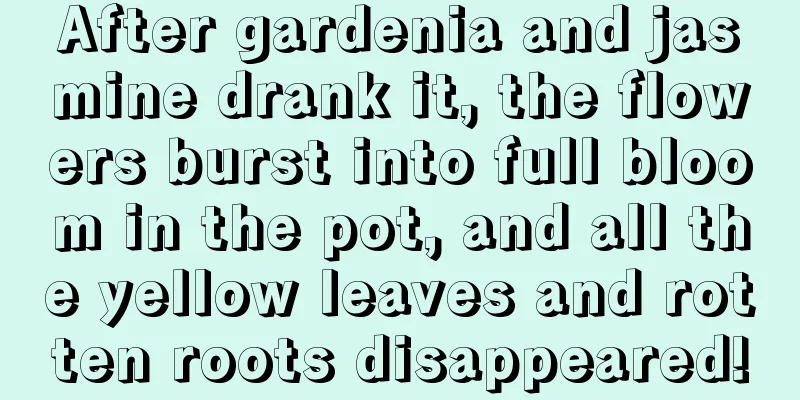After gardenia and jasmine drank it, the flowers burst into full bloom in the pot, and all the yellow leaves and rotten roots disappeared!

How to use vinegar when leaves turn yellow?FillingIf the leaves of gardenia, jasmine and money tree turn yellow and wilt, it may be caused by the soil being too alkaline, which can be adjusted with vinegar. Dosage and Administration:Dilute salt-free vinegar 50 times and use it to water the soil to adjust the soil pH and promote plant growth. If the leaves turn black, how to use vinegar?Leaf sprayThe leaves of green ivy and pothos turn black, getting dirtier and dirtier as time goes by, and it affects their appearance. In fact, it is because of lack of nutrition. Spraying some vinegar on them will immediately make them shiny green! Dosage and Administration:Dilute vinegar 300 times with water, spray it on the leaves in the morning or evening, once every 10 days or so, for 4 to 5 times in a row, the leaves will become greener and greener. How to use vinegar if the plant is short?Spray the whole plantWhen caring for camellia, jasmine, rose, etc., if the plants grow slowly, have small leaves, and few flower buds, you can spray some vinegar to promote growth and development. Dosage and Administration:Use a 300-fold diluted vinegar solution to spray the plants before bud formation. Spray once every 15 days or so. This can increase the size of the leaves and branches and the number of flowers. How to use vinegar for pest and disease infections?Spray the infested areaIn summer, roses are susceptible to powdery mildew, rhododendrons are susceptible to black spot disease, roses and peonies are susceptible to sooty mold disease, including other downy mildew diseases and leaf spot diseases, which can all be prevented and controlled with vinegar. Dosage and Administration:Dilute vinegar 150 times and spray it on the infested areas once a week, preferably in the morning or evening. Repeating 3 to 5 times will achieve effective control. There is a strong odor after fertilizing. How to use vinegar?FillingWhen you grow flowers indoors in the summer, after applying organic fertilizer, a fishy smell will spread throughout the room. If you pour in an appropriate amount of vinegar, the odor can be eliminated and it can also kill bacteria and disinfect. Dosage and Administration:Add a few drops of vinegar solution diluted more than 50 times to liquid fertilizer and water the soil to eliminate odor. Note: Huahua reminds everyone that you must first find out whether your flowers prefer acidic soil or alkaline soil. Do not use vinegar indiscriminately on alkali-loving plants such as cacti and pomegranates! Flower lovers, vinegar has so many wonderful uses Take a look and see if your flowers need some vinegar? |
>>: What to do if succulent plants have root rot
Recommend
Water hyacinth cultivation methods and precautions
Water hyacinth is very easy to grow. As long as y...
The Flower Language and Legend of Ginger Lotus
1. Flower language Many flowers have their own un...
What is the best month to plant irises?
When to plant irises Iris is generally propagated...
How to grow copper coin grass
Leaves are sparse Not everyone's pennywort gr...
When to plant potted calla lily? What kind of soil is best for growing calla lily?
1. Planting time of potted calla lily Calla lily ...
When is the best time to plant lily bulbs?
Lily is a common ornamental plant, and many frien...
How to propagate Dendrobium officinale at home? Is the survival rate of Dendrobium officinale high?
1. How to breed 1. Sowing: This method is not com...
How to grow purse flowers on the balcony, what should you pay attention to
1. Can it be grown on the balcony? During the gro...
Common diseases and pests of Chinese lantern tree and their prevention and control methods
Gummosis Symptoms of gum disease Gummosis mainly ...
Management of pomegranate flower blooming period
Pomegranate flower blooming period The peak flowe...
What is the appropriate spacing and depth for garlic planting?
In garlic production, reasonable density planting...
How to choose the medium for rice seedling cultivation? How to grow rice seedlings?
Now it is March, and rice seedling cultivation is...
What fertilizers can make grapes bloom and bear more fruits (a list of fertilizers for grape seedlings throughout the year)
There are many factors involved in making the bra...
How to raise chickens at home
In rural areas, family chicken farming is a commo...
What vegetables are suitable to grow in early spring?
What vegetables are suitable to grow in early spr...









